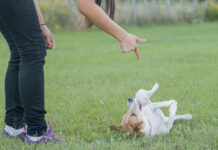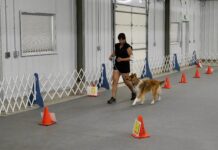[Updated February 6, 2019]
I’m a water-loving girl. I have a water-loving dog. I love the outdoors. What could be better than exploring local lakes and lazy rivers with my dog on a stand-up paddleboard?
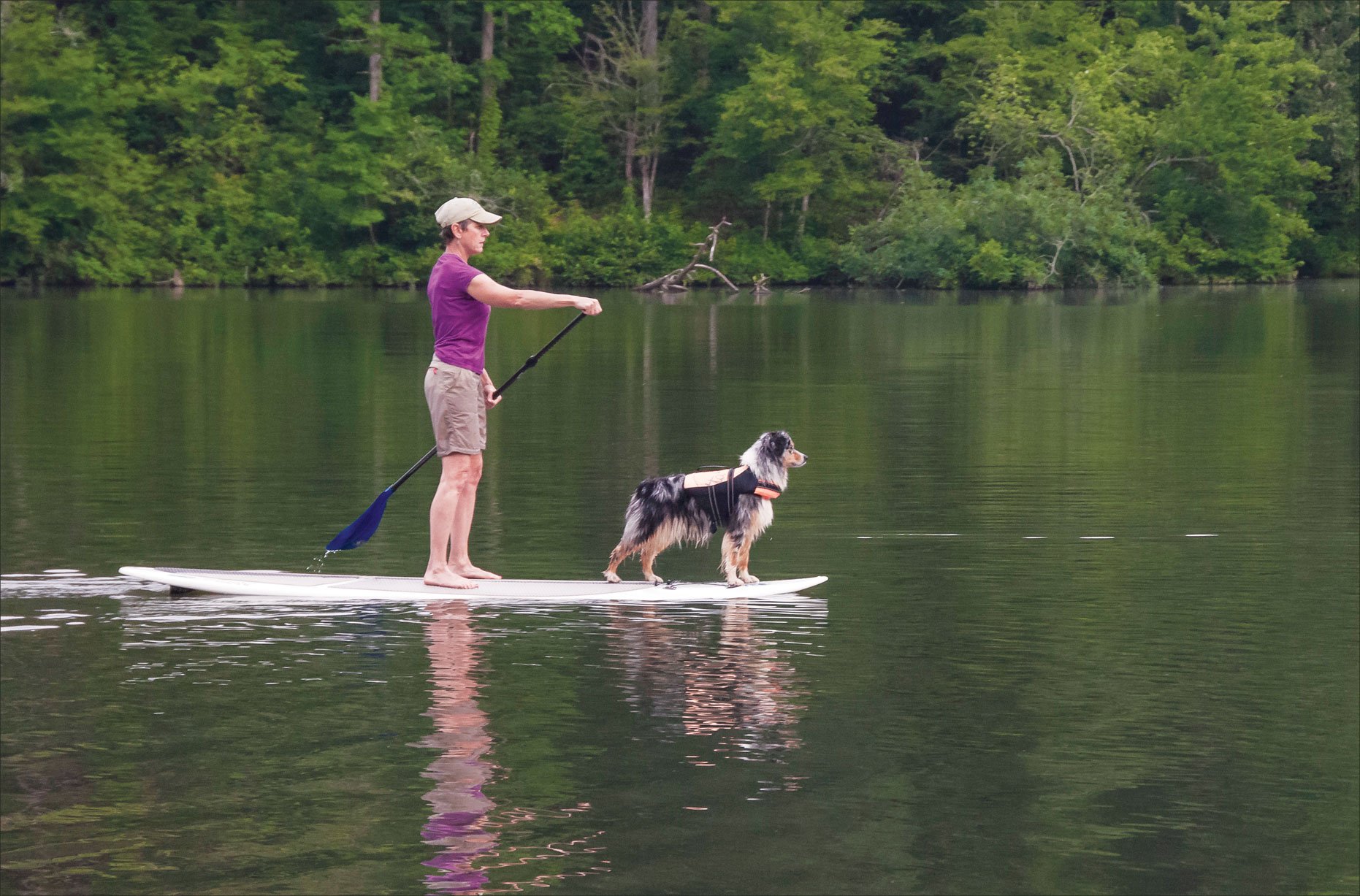
A stand-up paddleboard (SUP) is similar to a surfboard, though one paddles a SUP while standing. As a former avid whitewater kayaker, when I first saw photos of people on SUPs, I thought, “Why in the world would anyone want to do that?” Where was the excitement? The adrenaline?
Fast forward a few months later, when a girlfriend twisted my arm to give stand-up paddleboarding a try on the Tennessee River, which runs through downtown Chattanooga. I quickly realized this sport was much more fun than it looked in those photos. What’s more, all of us who tried it that day enjoyed the exercise and the view from the standing position on the board, and we didn’t fall in the drink! I had a new puppy, Willow, and I immediately saw this as something that she and I could enjoy together. That did it! Knowing that I could have that kind of fun with my dog was my main motivation to get involved in this sport.
If you like the outdoors and your dog enjoys water, stand-up paddleboarding (SUPing) is a fantastic way to spend time together. The added bonus is that it’s great exercise for both of you. Standing and balancing on the board while paddling seems to work every muscle in my body, and it seems to give my dog a good physical (and mental!) workout, too. If you tire of paddling, just plop yourself down on the board and take a break. Or hop off and take a swim with your dog. It doesn’t get much better.
Stand-up paddleboarding began in the 1960s when surfers used the technique in order to take photographs of other surfers. Around 2008, SUPing became popular with the creation of new, modern boards. Since then, the sport has spread rapidly around the world. Today, you can find people and their dogs paddleboarding in oceans, streams, rivers, and lakes. Boards are designed for specific types of water – even whitewater, but always keep your dog’s safety uppermost in mind. (I wouldn’t feel comfortable with my dog in whitewater, even with her life jacket on.)
Stand-up paddleboarding is a relatively easy sport with few equipment needs. At a minimum, you need a board (with a nice-sized deck pad that extends to the bow so both you and your dog have good footing), a paddle, a personal flotation device for you, and one for your dog. I recommend that you develop your own basic stand-up paddleboarding skills and gain some confidence on the water before teaching your dog to enjoy the sport with you.
Paddleboarding Prerequisites for Your Dog
Your dog should possess a few traits and skills before you consider her seriously as a paddleboarding partner:
1. Love of the Water.
Many dogs naturally take to water and swimming, so if your dog already loves the water, fantastic. If not, you may be able to develop her enthusiasm for water. Find a lake or pool with a shallow area and bring out the fun! Pair the new experience of two or four paws in shallow water with an enjoyable game of tug, or feed your dog high-value treats while her paws are in the water.
One caveat: Don’t ever push or throw your dog in the water. Dogs are always making decisions about what’s safe and what’s not, so make sure your dog has a pleasant experience near and in the water. And some dogs might not ever take to swimming. Our 6-year-old male Australian Shepherd is one such dog; Cody is comfortable only in very shallow water. This sport would not be for him and that’s okay. There are plenty of other activities we can enjoy together that don’t involve water.
2. Ability to Swim.
Swimming didn’t come naturally to our other Aussie, Willow, either, but she developed this skill over time, and to watch her now, you would never know that she wasn’t always comfortable in water. As a pup, she liked wading in the shallows, but wouldn’t go more than belly-deep on her own. To help her gain confidence, I cradled her under her belly, let her dog-paddle for a few seconds, then quickly set her back down where her paws could touch bottom. I also used friends’ water-loving dogs to encourage Willow into the water.
A canine flotation device can help a dog feel more comfortable. There are a variety of well-made dog lifejackets available. I use the Hurtta jacket because of its secure fit, multiple buckles for adjustment, and wide, stretchable belly band. As with many dog lifejackets, the back is made with a sturdy handle that allows the handler to easily guide the dog in the water or lift the dog out of the water. If your dog jumps or falls off the board, you can use the handle to get her easily back up on the board.
3. Basic Foundation Skills.
Before paddleboarding with your dog, she should have mastered basic foundation skills such as sit, down, targeting, wait, and recall. Recall is extremely important, since your dog will be off leash before, during, and immediately after your SUPing adventures. If you’ve already done some shaping with your dog, these skills will come in handy.
Teaching Your Dog to LOVE Your Board & Paddle
Once you are confident that your dog possesses all the prerequisites for paddleboarding, use classical conditioning techniques to help your dog develop a positive association with your SUP and paddle and to think the board is the best toy in the universe. To your dog, the board and paddle are new, unusual pieces of equipment. Many dogs, including our older Aussie, Cody, shy away from a long paddle when it’s held in a vertical position. Go slowly during the introduction period and move at a pace that’s comfortable for your dog.
Because Willow is such a confident dog and was only eight months old when I began teaching her, it took just a few short sessions for her to become comfortable with the equipment. However, if your dog adjusts slowly to new, unusual things or environments, spend as much time as necessary for your dog to show you through her exuberance that she loves the board. You know that “Whoopee!” look you get when you pick up your dog’s leash? That’s the look you should get when you pull out your board.
If you have room, place your SUP and paddle inside your home in an area where your dog already enjoys spending time with you. This is a great way to pair fun experiences with your new SUP. You can play games with your dog near the board, have fun training sessions near the board, let your dog enjoy a food-stuffed Kong toy beside or on the board, and even feed your dog meals from a bowl on the board.
Do the same exercises with the paddle. When it’s time to pick up the paddle and hold it vertically, enlist the help of a friend to hold and move the paddle while you’re feeding your dog treats or playing games with her around the moving paddle. Our home is so small that bringing the board inside wasn’t an option, so I did all these things outdoors.
Once your dog is comfortable with the board inside, it’s time to do some outside training on dry land. Willow has such a positive classically conditioned response to the board that I can barely begin to pick it up before she’s trying to hop on it.
I’m a clicker trainer; I build behaviors by using the sound of a clicker as a signal to let the dog know when she does a behavior I like, and then reinforce her with a yummy piece of food. I also do a lot of shaping, which helps a dog learn to interact with new objects. Because I’ve done so much shaping with Willow, when I first placed the board on the grass, she immediately began interacting with it. I merely clicked the clicker and gave her a treat for any interaction with the board (a sniff, a nose touch, a paw up, etc.) and before long she was readily hopping onto the middle of the board.
You can use food or a toy to lure your dog on and off the board (see Photo 1, facing page), but you’ll want to remove or “fade” the use of any lures as quickly as possible, so your dog understands that it’s getting on and off the board that is being rewarded, not just following the lure.
You can use any of these techniques to encourage your dog to hop on and off the board. Once your dog is happily moving on and off the board, add some cues for getting on and off. My hop-on cue is, “Surf’s up!” and my get-off cue is “Off!”
Handy Targeting Lessons
Stand-up paddleboarding demands that you and your dog learn to balance. You are most stable when you’re standing near the middle of the board and your dog is positioned in front of you. “Targeting” is a great tool to use to get your dog to go to the best spot on the board for stability. To target, you teach your dog to touch a part of her body (usually, her nose, paw, or shoulders – whatever you choose) to your hand or an object (such as a “target stick,” a short stick with a ball on one end).
I used both nose targeting and body targeting to teach Willow where to be on the board. She already knew how to follow my hand into various positions in order to touch it with her nose. Using this technique, I taught her to walk through my legs from behind me and sit right in front of me. With her behind me, I stood with my legs wide apart, placed my target hand in front of and in between my knees, and cued her to target my hand, and then sit. Voila! She was right where she needed to be (see Photo 2). Once she was reliably moving through my legs and into a sit, I added the cue, “Peek!”
This exercise came in handy when SUP training on land to help me position her body where I wanted her to be on the board. It was also incredibly useful when we made our maiden voyage on flat water. Excited, she wanted to wander around the board, which made it challenging for me to balance. Having her target my hand was an easy way to position her so that we could successfully paddle around without falling.
Another targeting technique is to use a mat to teach your dog to put her body in a certain place. To start, you teach your dog to sit and wait with her entire body on a mat. Practice with the mat in a variety of locations in your home, outside on your porch, in your yard, on a dock, and on grass by a lake. When she understands her “go to the mat” cue, put the mat on your paddleboard – at first, on land! Because your dog has learned to sit and wait on the mat in a variety of places, the exercise should transfer well to your SUP. Begin with a mat large enough to fit your dog’s entire body, then decrease the size of the mat by cutting it into smaller and smaller pieces, until you fade it out entirely.
Achieving Balance
I’ve had Willow on all manner of wobbly, rolling surfaces since she first entered our home at nine weeks of age, so she already had good balance and was comfortable on a variety of moving surfaces before I started SUPing. When traveling and staying in hotels, I’ve had Willow hop up on a rolling luggage cart and fed her yummy treats as I slowly rolled the cart around.
If you haven’t already, help your dog become comfortable with balancing on a moving surface prior to beginning board work on the water. A couple of fun training tools are a wobble board and a FitPAWS Balance Disc. Be creative!
Time to Hit the Water!
Once you’re certain your dog is comfortable and has a positive association (that “Whoopee!” look) with the board, the paddle, and moving surfaces, it’s time for the water work.
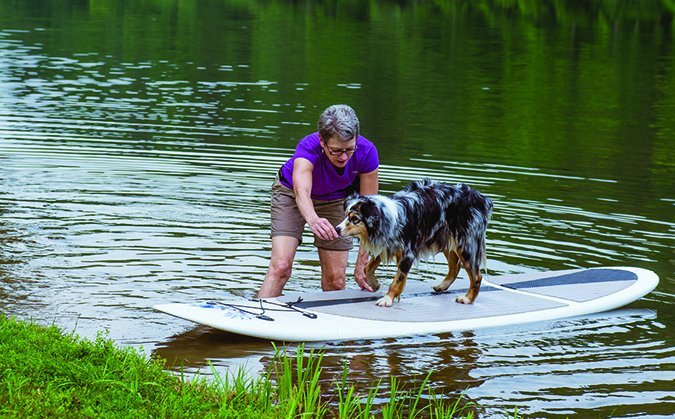
Choose a nice, warm, sunny, calm day on a flat water surface. I’m fortunate to live near many beautiful lakes, but even a small pond can work. Begin with the board partially in the water and partially on land (see Photo 3). Cue your dog to get on the board, praise her for doing so, and feed her bits of yummy food the entire time she’s on it. When she steps off, stop the “food bar,” thus classically conditioning her to better enjoy being on the board than off!
Make her time on the board only seconds at first, then slowly increase the length of time you ask her to stay on the board. You want your dog to have a positive experience, so go slowly. If at any time, she seems uncomfortable, move back to dry land beside the water and continue there until she has that “Whoopee!” look.

Once your dog is comfortable with being on the board partially in the water, place the board fully in shallow water (avoiding any rocks or hard surfaces; see Photo 4. While steadying the board with your hand, cue your dog to get on the board. Be fun and upbeat, and praise and reward her as you slowly move the board around. If she hops off before you cue her to do so, no worries. Just begin again and eventually she’ll get the hang of it. If your dog seems at all uncomfortable, go back to where she was last happy and successful and spend more time on that step before proceeding.
Next, sit on the board with your dog and paddle around. Then kneel on the board and paddle around. Once your dog is comfortable riding the board with you kneeling and paddling on flat water, it’s time to stand up!
Standing and balancing with your dog on the board is a new challenge for both of you. Either one of you could lose your balance and fall off, so practice doing some fake falls (or just jumping in)and make it a fun experience for both of you. That way, when the unexpected fall happens, you’ll both be better prepared.
When you’re ready to stand, come up onto all fours (both knees and both hands), positioning your knees on either side of the handle in the middle of the board. Your paddle should be perpendicular to the board and your palms should be on the paddle. Come up on one foot, then the other, by bringing your feet toward your hands. If you’re feeling a bit wobbly, your dog may be, too, so continue to be upbeat and praise your dog for being the “best dog in the whole world!”
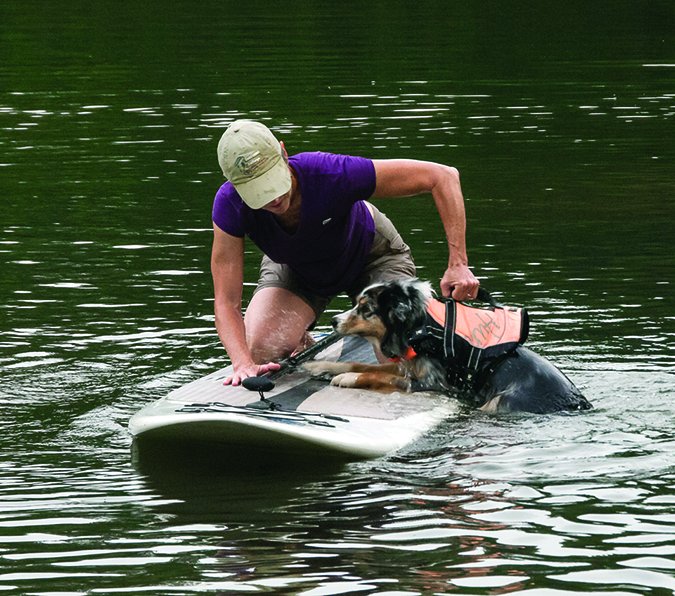
Be prepared to shift your position on the board in response to your dog’s movements. Ideally, both you and your dog will stay in one spot on the board. Make your maiden voyage very short, praising your dog the entire time, then return to your knees before getting off the board (providing more stability for both you and your dog).
It’s natural for dogs to move about the board when they’re first learning (yes, even if you’ve cued them to wait). It’s a new, unusual experience for them, so until they learn to be still, you’ll need to make minor or even major adjustments when they move unexpectedly. Remember to smile through it all!
Some dogs prefer to ride toward the bow (front) of the board. If this is the case with your dog, move backward a step or two to balance the board so that it tracks through the water with ease. Too much forward weight will cause the bow to dip under the surface. Too much weight on the stern (back of the board) will cause the stern to dip under water and the bow will be too far above the water.
Safety First Always!
As I mentioned earlier, before you ever invite your dog to join you on a SUP, it’s imperative that you are comfortable on your board and that you have practiced falling off and getting back on. The more experience you have with practice falls, the better you’ll be when the unexpected happens. Always have yo¬¬¬ur dog wear a lifejacket, no matter how well she swims, since you may find yourself having so much fun that you paddle far from shore. Make it a habit to check the weather forecast before you head out. Take the right clothing for the weather, and always remember to bring drinking water for you and your dog.
Ready to Give It A Try?
If you think you might enjoy this sport, try renting a SUP first; most surf shops now rent paddleboards and there are many niche SUP shops popping up all over the country, especially in areas with lakes and rivers. Take advantage of a day’s rental and find out how fun SUPing can be. If you really like it, then you can look for a paddleboard to buy (new or used; don’t forget craigslist.org!), and start honing your skills on the water while doing dry-land training with your dog. Before you know it, you’ll be SUPing into the sunset with your favorite furry friend on board.
Video Links & Recommended Equipment
Video of Stand-up paddleboarding for beginners
Stand-up Paddlingboarding Basics
How to Choose a Paddleboard
Using social facilitation to help a dog learn to love water
youtube.com/watch?v=qeOzv1-T7Fs
youtube.com/watch?v=amUuNFaBgSU
Safety and comfort with doggie life jacket
tinyurl.com/swimmingpractice
Hand Targeting on Maiden Voyage
youtube.com/watch?v=zfYDuhf6bwQ
Recommended Equipment
The following prices are for new equipment. Buying used equipment can help reduce your investment.
Stand-up paddleboard $600 – $1,500
Boards with extended deck pads are preferable so that your dog has a safe, non-slippery area.
If the deck pad doesn’t extend to the bow, a textured surface on the bow is preferred, though you can add deck padding to either a textured or slick bow.
Length/weight of the board depends on combined weight of you and your dog.
Paddle $80 – $225
Personal Flotation Device (pfd) for your dog $25 – $75
PFD for you $50 – $200
A paddleboard is considered a vessel by the U.S. Coast Guard, whose regulations require that adults have a Coast Guard-approved Type I, II, or III personal flotation device (PFD) on board when paddling beyond the limits of swimming or surfing areas.
Proper clothing
You’ll need different clothing depending on the weather (wetsuit or drysuit for colder weather, T-shirt and shorts or bathing suit for warmer weather).
Whistle and light $5 each
These are safety measures should you need to summon help and/or are unexpectedly caught out after dark. There are many waterproof LED lights available for various sports (such as bicycling).
Safety Leash/tether $14 – $30
A safety leash or tether is recommended in any type of moving water or in ocean surf. If you fall off your board, the ankle leash keeps your board near you. Coiled and uncoiled leashes are available. These are not necessary for lake paddling, though they’re nice to have if you’re on a slow-moving river or in the ocean.
Drinking Water for you and your dog $30 and up
If you paddleboard in salt water, brackish water, or potentially polluted water, bring clean drinking water for your dog, as well as a collapsible bowl. You can carry the water in a collapsible water bottle or wearable hydration pack (such as Camelbak, etc.).
First-aid kit $15 and up
Should include sunscreen, emergency contact info, your dog’s info (including vaccination records) and your vet’s contact info.
Dry bag $3 – $25
These are the perfect thing for holding snacks for you and your dog, as well as dry clothing. I’ve used water resistant “dry bags” from Walmart that cost only $3 and worked fine, although they were never submerged (the real test of a quality dry bag). More expensive models designed for kayaking and other water sports can be submerged and still keep their contents dry.
Stay tuned for Lisa Lyle Waggoner’s Stand-Up Paddleboarding DVD from Tawzer Dog, which will be available before the end of 2014.
A passionate advocate for humane, science-based dog training, Lisa Lyle Waggoner is a CPDT-KA, a Pat Miller Certified Trainer Level 2, a Pat Miller Level 1 Canine Behavior & Training Academy instructor, and a dog*tec Dog Walking Academy Instructor. The founder of Cold Nose College in Murphy, North Carolina, Lisa provides behavior consulting and training solutions to clients in the tri-state area of North Carolina, Georgia, and Tennessee.



